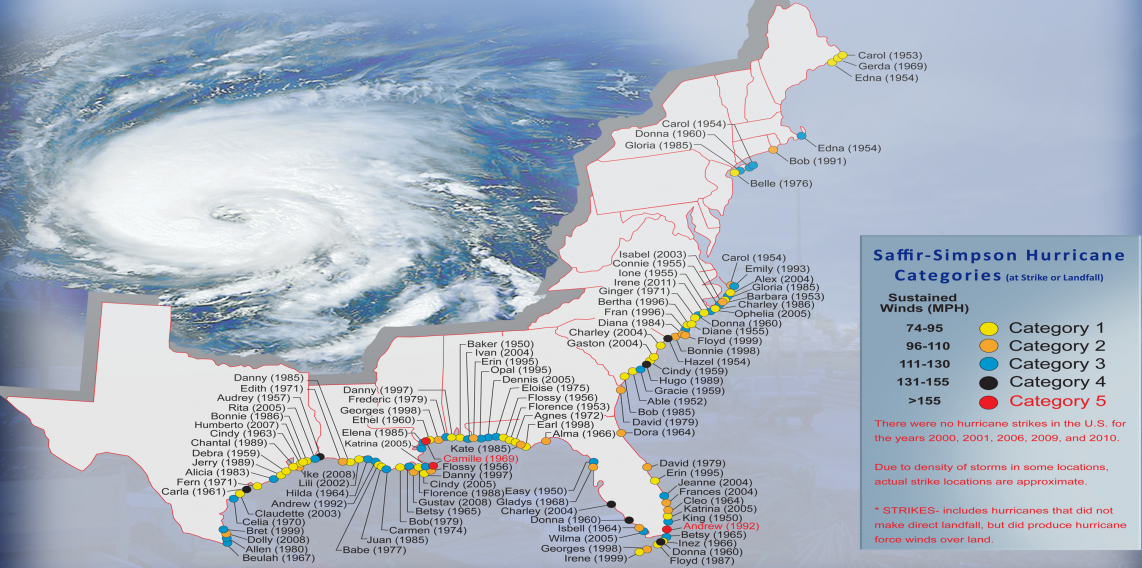Analyses & Forecasts
▾
Data & Tools
▾
Educational Resources
▾
Archives
▾
About
▾
Search
Search ForNWS All NOAA
▾
Climatology | Names | Wind Scale | Extremes | Models | Breakpoints
Experience shows that the use of short, distinctive names in written as well as spoken communications is quicker and less subject to error than the older, more cumbersome latitude-longitude identification methods.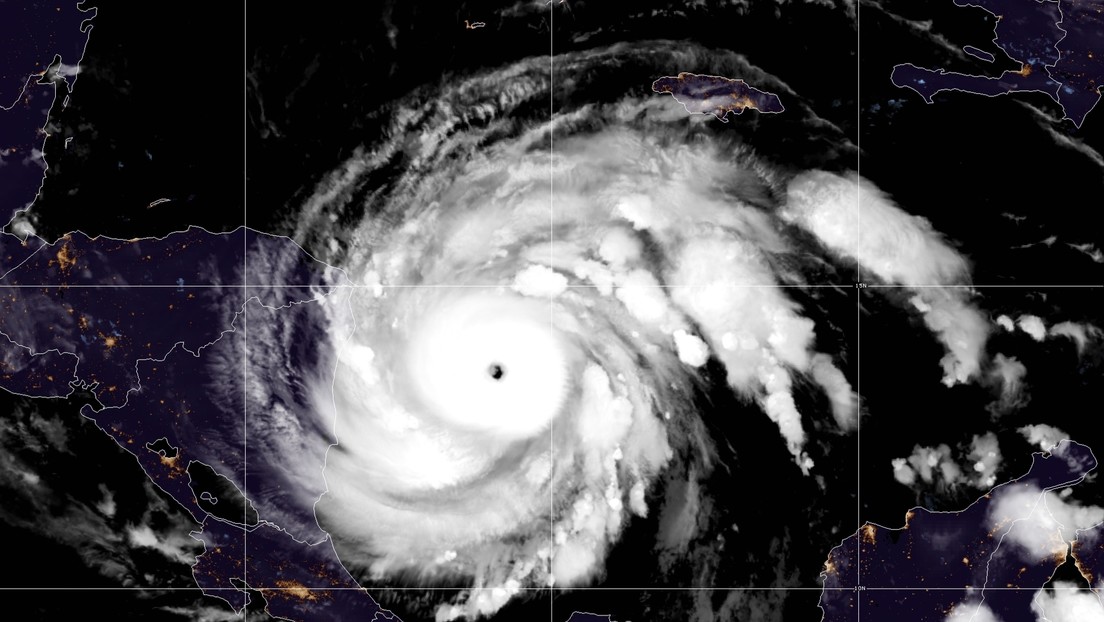 These advantages are especially important in exchanging detailed storm information between hundreds of widely scattered stations, coastal bases, and ships at sea.
These advantages are especially important in exchanging detailed storm information between hundreds of widely scattered stations, coastal bases, and ships at sea.
The use of easily remembered names greatly reduces confusion when two or more tropical storms occur at the same time. For example, one hurricane can be moving slowly westward in the Gulf of Mexico, while at exactly the same time another hurricane can be moving rapidly northward along the Atlantic coast. In the past, confusion and false rumors have arisen when storm advisories broadcast from radio stations were mistaken for warnings concerning an entirely different storm located hundreds of miles away.
Can I have a tropical cyclone named for me?
For several hundred years many hurricanes in the West Indies were named after the particular saint's day on which the hurricane occurred. Ivan R. Tannehill describes in his book "Hurricanes" the major tropical storms of recorded history and mentions many hurricanes named after saints. For example, there was "Hurricane Santa Ana" which struck Puerto Rico with exceptional violence on July 26, 1825, and "San Felipe" (the first) and "San Felipe" (the second) which hit Puerto Rico on September 13 in both 1876 and 1928.
For example, there was "Hurricane Santa Ana" which struck Puerto Rico with exceptional violence on July 26, 1825, and "San Felipe" (the first) and "San Felipe" (the second) which hit Puerto Rico on September 13 in both 1876 and 1928.
Tannehill also tells of Clement Wragge, an Australian meteorologist who began giving women's names to tropical storms before the end of the 19th century.
An early example of the use of a woman's name for a storm was in the novel "Storm" by George R. Stewart, published by Random House in 1941, and since filmed by Walt Disney. During World War II this practice became widespread in weather map discussions among forecasters, especially Army and Navy meteorologists who plotted the movements of storms over the wide expanses of the Pacific Ocean.
In 1953, the United States abandoned a confusing two-year old plan to name storms by a phonetic alphabet (Able, Baker, Charlie) when a new, international phonetic alphabet was introduced. That year, the United States began using female names for storms.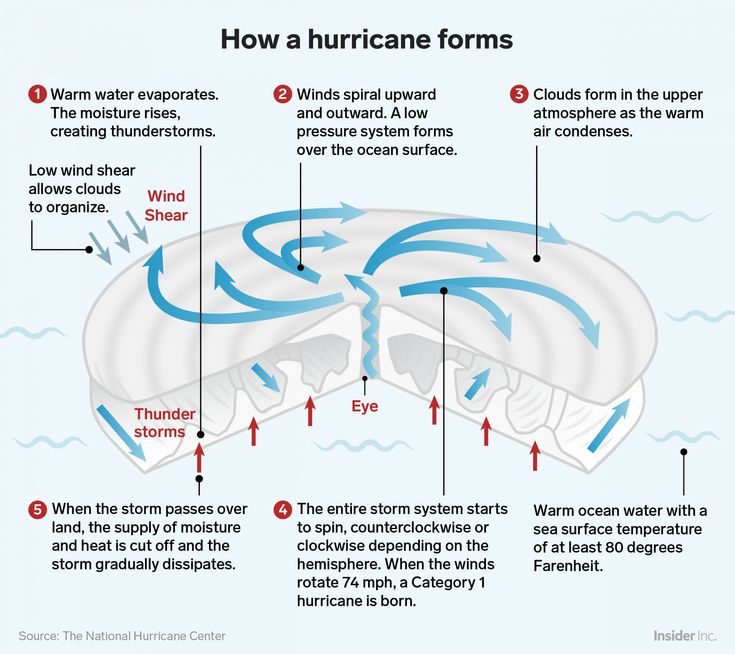
The practice of naming hurricanes solely after women came to an end in 1978 when men's and women's names were included in the Eastern North Pacific storm lists. In 1979, male and female names were included in lists for the Atlantic and Gulf of Mexico.
The NHC does not control the naming of tropical storms. Instead a strict procedure has been established by an international committee of the World Meteorological Organization.
For Atlantic hurricanes, there is a list of names for each of six years. In other words, one list is repeated every sixth year. The only time that there is a change is if a storm is so deadly or costly that the future use of its name on a different storm would be inappropriate for obvious reasons of sensitivity. If that occurs, then at an annual meeting by the committee (called primarily to discuss many other issues) the offending name is stricken from the list and another name is selected to replace it.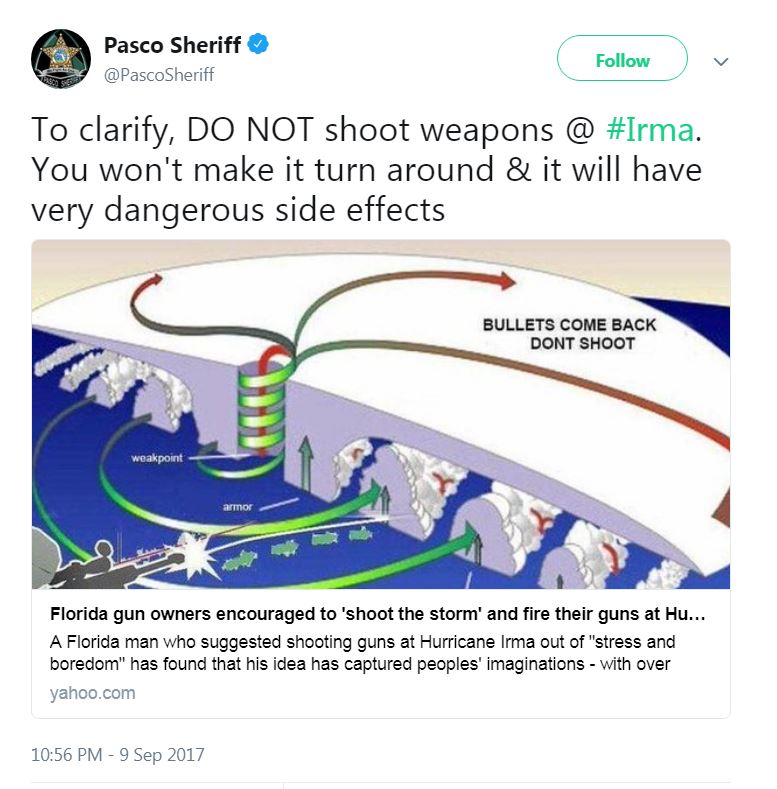
There is an exception to the retirement rule, however. Before 1979, when the first permanent six-year storm name list began, some storm names were simply not used anymore. For example, in 1966, "Fern" was substituted for "Frieda," and no reason was cited.
Below is a list of retired names for the Atlantic Ocean, Caribbean Sea, and the Gulf of Mexico. There are, however, a great number of destructive storms not included on this list because they occurred before the hurricane naming convention was established in 1950.
Can I have a tropical cyclone named for me?
| 1954 Carol Hazel Edna | 1955 Connie Diane Ione Janet | 1956 | 1957 Audrey | 1958 | 1959 | 1960 Donna | 1961 Carla Hattie | ||
| 1962 | 1963 Flora | 1964 Cleo Dora Hilda | 1965 Betsy | 1966 Inez | 1967 Beulah | 1968 | 1969 Camille | 1970 Celia | 1971 |
| 1972 Agnes | 1973 | 1974 Carmen Fifi | 1975 Eloise | 1976 | 1977 Anita | 1978 Greta | 1979 David Frederic | 1980 Allen | 1981 |
| 1982 | 1983 Alicia | 1984 | 1985 Elena Gloria | 1986 | 1987 | 1988 Gilbert Joan | 1989 Hugo | 1990 Diana Klaus | 1991 Bob |
| 1992 Andrew | 1993 | 1994 | 1995 Luis Marilyn Opal Roxanne | 1996 Cesar Fran Hortense | 1997 | 1998 Georges Mitch | 1999 Floyd Lenny | 2000 Keith | 2001 Allison Iris Michelle |
| 2002 Isidore Lili | 2003 Fabian Isabel Juan | 2004 Charley Frances Ivan Jeanne | 2005 Dennis Katrina Rita Stan Wilma | 2006 | 2007 Dean Felix Noel | 2008 Gustav Ike Paloma | 2009 | 2010 Igor Tomas | 2011 Irene |
| 2012 Sandy | 2013 Ingrid | 2014 | 2015 Erika Joaquin | 2016 Matthew Otto | 2017 Harvey Irma Maria Nate | 2018 Florence Michael | 2019 Dorian | 2020 Laura Eta Iota | 2021 Ida |
| Agnes | 1972 | |
| Alicia | 1983 | |
| Allen | 1980 | |
| Allison | 2001 | |
| Andrew | 1992 | |
| Anita | 1977 | |
| Audrey | 1957 | |
| Betsy | 1965 | |
| Beulah | 1967 | |
| Bob | 1991 | |
| Camille | 1969 | |
| Carla | 1961 | |
| Carmen | 1974 | |
| Carol | 1954 | |
| Celia | 1970 | |
| Cesar | 1996 | |
| Charley | 2004 | |
| Cleo | 1964 | |
| Connie | 1955 | |
| David | 1979 | |
| Dean | 2007 | |
| Dennis | 2005 | |
| Diana | 1990 | |
| Diane | 1955 | |
| Donna | 1960 | |
| Dora | 1964 | |
| Dorian | 2019 | |
| Edna | 1954 | |
| Elena | 1985 | |
| Eloise | 1975 | |
| Erika | 2015 | |
| Eta | 2020 | |
| Fabian | 2003 | |
| Felix | 2007 | |
| Fifi | 1974 | |
| Flora | 1963 | |
| Florence | 2018 | |
| Floyd | 1999 | |
| Fran | 1996 | |
| Frances | 2004 | |
| Frederic | 1979 | |
| Georges | 1998 | |
| Gilbert | 1988 | |
| Gloria | 1985 | |
| Greta | 1978 | |
| Gustav | 2008 | |
| Harvey | 2017 | |
| Hattie | 1961 | |
| Hazel | 1954 | |
| Hilda | 1964 | |
| Hortense | 1996 | |
| Hugo | 1989 | |
| Ida | 2021 | |
| Igor | 2010 | |
| Ike | 2008 | |
| Inez | 1966 | |
| Ingrid | 2013 | |
| Ione | 1955 | |
| Iota | 2020 | |
| Irene | 2011 | |
| Iris | 2001 | |
| Irma | 2017 | |
| Isabel | 2003 | |
| Isidore | 2002 | |
| Ivan | 2004 | |
| Janet | 1955 | |
| Jeanne | 2004 | |
| Joan | 1988 | |
| Joaquin | 2015 | |
| Juan | 2003 | |
| Katrina | 2005 | |
| Keith | 2000 | |
| Klaus | 1990 | |
| Laura | 2020 | |
| Lenny | 1999 | |
| Lili | 2002 | |
| Luis | 1995 | |
| Maria | 2017 | |
| Marilyn | 1995 | |
| Matthew | 2016 | |
| Michael | 2018 | |
| Michelle | 2001 | |
| Mitch | 1998 | |
| Nate | 2017 | |
| Noel | 2007 | |
| Opal | 1995 | |
| Otto | 2016 | |
| Paloma | 2008 | |
| Rita | 2005 | |
| Roxanne | 1995 | |
| Sandy | 2012 | |
| Stan | 2005 | |
| Tomas | 2010 | |
| Wilma | 2005 |
| 1965 Hazel | 1966 | 1967 | 1968 | 1969 | 1970 Adele | 1971 | |||
| 1972 | 1973 | 1974 | 1975 | 1976 | 1977 | 1978 Fico | 1979 | 1980 | 1981 |
| 1982 Iwa | 1983 | 1984 | 1985 | 1986 | 1987 Knut | 1988 Iva | 1989 | 1990 | 1991 Fefa |
| 1992 Iniki | 1993 | 1994 | 1995 Ismael | 1996 | 1997 Pauline Paka | 1998 | 1999 | 2000 | 2001 Adolph |
| 2002 Kenna | 2003 | 2004 Isis | 2005 | 2006 Ioke | 2007 | 2008 Alma | 2009 | 2010 | 2011 |
| 2012 | 2013 Manuel | 2014 Odile | 2015 Patricia | 2016 | 2017 | 2018 | 2019 | 2020 | 2021 |
| Adele | 1970 | |
| Adolph | 2001 | |
| Alma | 2008 | |
| Fefa | 1991 | |
| Fico | 1978 | |
| Hazel | 1965 | |
| Ioke | 2006 | |
| Isis | 2004 | |
| Ismael | 1995 | |
| Iniki | 1992 | |
| Iva | 1988 | |
| Iwa | 1982 | |
| Kenna | 2002 | |
| Knut | 1987 | |
| Manuel | 2013 | |
| Odile | 2014 | |
| Paka | 1997 | |
| Patricia | 2015 | |
| Pauline | 1997 |
In the event that more than twenty-one named tropical cyclones occur in the Atlantic basin in a season, or more than twenty-four named tropical cyclones in the eastern North Pacific basin, any additional storms will take names from an alternate list of names approved by the WMO for each basin. This naming convention has been established by the World Meteorological Organization Tropical Cyclone Programme.
This naming convention has been established by the World Meteorological Organization Tropical Cyclone Programme.
| Atlantic Basin | Eastern North Pacific Basin |
|---|---|
| Adria Braylen Caridad Deshawn Emery Foster Gemma Heath Isla Jacobus Kenzie Lucio Makayla Nolan Orlanda Pax Ronin Sophie Tayshaun Viviana Will | Aidan Bruna Carmelo Daniella Esteban Flor Gerardo Hedda Izzy Jacinta Kenito Luna Marina Nancy Ovidio Pia Rey Skylar Teo Violeta Wilfredo Xinia Yariel Zoe |
The 2022 Atlantic hurricane season got off to a slow start but the National Oceanic and Atmospheric Administration (NOAA) and FEMA advise not to be complacent. Every year NOAA makes predictions about the number and severity of the dangerous cyclones, and once again this year is expected to be above normal.
Every year NOAA makes predictions about the number and severity of the dangerous cyclones, and once again this year is expected to be above normal.
The agency expects a greater number of storms to form in the Gulf of Mexico and Atlantic region this year thanks to the La Niña weather phenomenon which brings warmer than average temperatures to the region. As with any season the predicted fourteen to twenty-one named storms, with between six to ten becoming hurricanes, will all have a name waiting for them when they form.
In the mid twentieth century, the US government began naming storms to simplify communications and informing the public about them. Before, NOAA often used positions or latitude and longitude to communicate about storms but this becomes very confusing when there is more than one present in a specific area at a time.
A storm is given a name when its winds reach more than thirty miles per hour.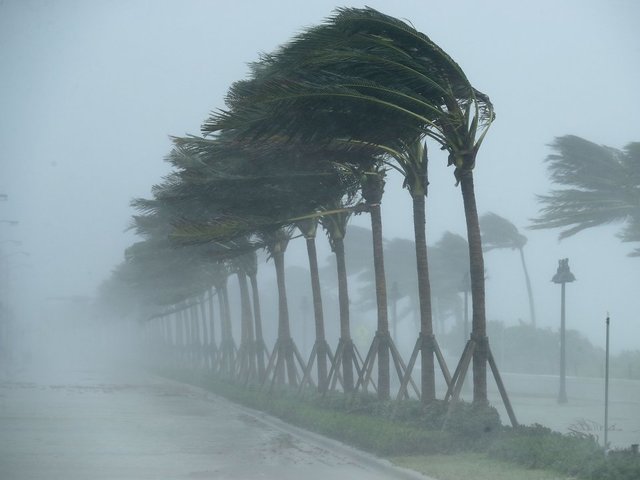 The World Meteorological Organization, which selects the names, upgrades the storm to a hurricane or typhoon if the winds reach more than 119 miles per hours.
The World Meteorological Organization, which selects the names, upgrades the storm to a hurricane or typhoon if the winds reach more than 119 miles per hours.
Neither the World Meteorological Organization nor NOAA invented this practice. In Puerto Rico records show that as early as 1876, before becoming a colony of the United States, some on the island would christen each storm with the name of a Saint. A meteorologist in Australia also popularized the practice in the 19th century, which was adopted by the US in the 1950s.
In the first few decades of using this method NOAA had only selected women’s names for storms. However, in the 1970s this practice was ended and traditionally male names were used. This did lead to a phenomenon noted by social scientists where storms with female names were thought of as weaker and less of a threat; highlighting the ways in which gender bias informs a society’s perception of a threat. It is important to remember that the severity of a storm has no influence over the name that is selected.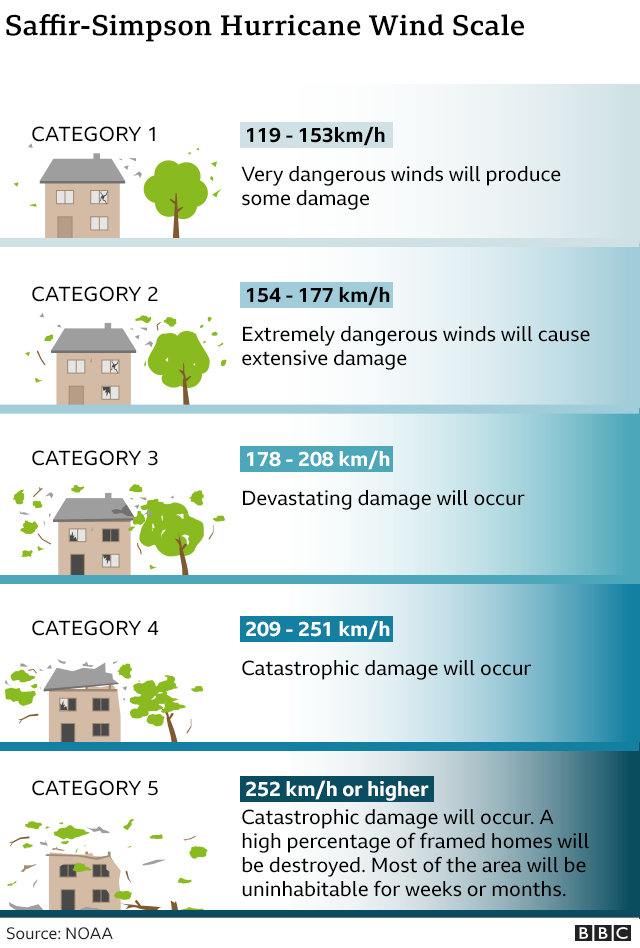 Quite the opposite.
Quite the opposite.
Twenty-one storm names have already been chosen for each of the next six years, letters Q, U, X, Y and Z are not used. As the storms emerge they will be given a name in alphabetical order, and should there be more than twenty-one, the names will be taken from an alternate list approved by the WMO. The lists are recycled every six years.
NOAA has reported that “if a storm is so deadly or costly that the future use of its name on a different storm would be inappropriate for obvious reasons of sensitivity,” it can be retired. Since 2000, forty-four names have been taken out of circulation. This compares to twenty-two names retired between 1980 and 1999. This means that since the beginning of this century more than double the names have been retired than the previous two decades --an indicator of the impact of climate change on storm severity.
This means that since the beginning of this century more than double the names have been retired than the previous two decades --an indicator of the impact of climate change on storm severity.
Hurricane is the name of tropical cyclones, mainly in North and South America. The word "hurricane" itself is a distorted name of the god of fear Hurakan among the Indians of the South American Quiche tribe.
In the western Pacific Ocean, hurricanes are called "typhoons" (from the Chinese "tai fung" or "tai feng", which means "big wind"), in the Indian Ocean and the Bay of Bengal - "cyclones", off the coast of Australia - "willy willy ", in Oceania - "willy wow", and in the Philippines - "baguio".
Hurricanes form as cyclones in the intertropical belt above the world's oceans when the water temperature exceeds 26 degrees Celsius. A hurricane creates a perturbation (a sudden disruption in the normal course of something), which occurs when warm and moist air that comes into contact with the sea begins to rise. Having reached great heights, it condenses, releasing heat. It causes other masses of hot air to rise and condense, a kind of chain reaction occurs. Meanwhile, the air currents begin to rotate in a counter-clockwise direction (clockwise in the Southern Hemisphere) due to the rotation of the Earth, dragging clouds of perturbation with them. When the wind speed reaches 130 kilometers per hour, it becomes a hurricane. Hurricanes in the Northern Hemisphere, due to the rotation of the Earth, move westward (from Africa towards America) at a speed that initially does not exceed 20-25 km per hour.
Having reached great heights, it condenses, releasing heat. It causes other masses of hot air to rise and condense, a kind of chain reaction occurs. Meanwhile, the air currents begin to rotate in a counter-clockwise direction (clockwise in the Southern Hemisphere) due to the rotation of the Earth, dragging clouds of perturbation with them. When the wind speed reaches 130 kilometers per hour, it becomes a hurricane. Hurricanes in the Northern Hemisphere, due to the rotation of the Earth, move westward (from Africa towards America) at a speed that initially does not exceed 20-25 km per hour.
A tropical storm is named when its accompanying winds are above 62 kilometers per hour.
The Saffir-Simpson scale, which calculates potential damage from hurricanes, has five levels in total.
A storm becomes a Category 1 hurricane when its accompanying winds exceed 119 kilometers per hour.
Severe building damage in the disaster area begins with Category 3 hurricanes, which are assigned to a hurricane when wind speeds rise to 178 kilometers per hour.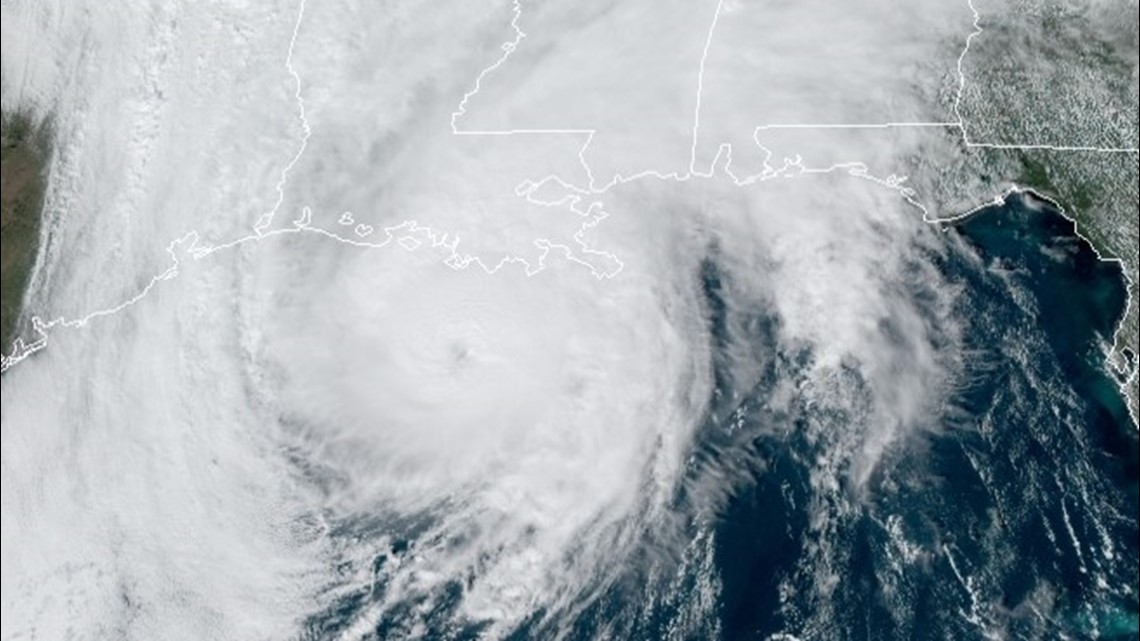
Category 5 hurricane assumes wind speeds of 250 kilometers per hour and leads to total catastrophic consequences.
In the Atlantic, the hurricane season begins in June and continues until November. The seasonal norm, determined over a number of years (1981-2010), is considered to be the formation of 12 storms, of which six become hurricanes, including three very intense hurricanes.
The most destructive season for the Atlantic was the 2005 season, when 28 named storms were recorded, 15 of which were hurricanes, four of which hit the US coast, including Katrina, which killed more than 1.3 thousand people in southern states.
In the 2012 season, Hurricane Sandy became the 18th named tropical cyclone and the 10th such cyclone in the Atlantic.
A typhoon is a type of tropical cyclone that is typical of the Pacific Northwest.
The zone of typhoon activity, which accounts for one third of the total number of tropical cyclones on Earth, is enclosed between the coast of East Asia in the west, the equator in the south and the date line in the east.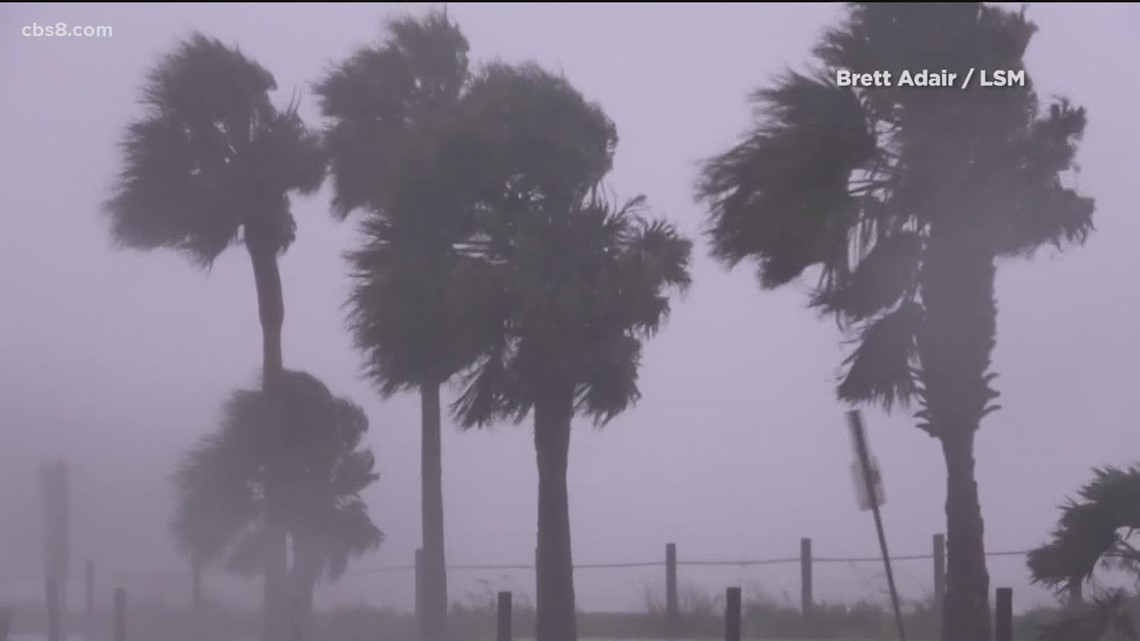 Moving from the west and northwest at a speed of 10-20 km/h, typhoons reach the shores of Indochina, China, and Korea. The frequency of typhoons is greater than that of tropical cyclones in any other region of the globe. On average, there are about 30 typhoons per year, most of which develop to the stage of a hurricane (wind speed over 30 m/s), the rest reach the stage of a tropical storm.
Moving from the west and northwest at a speed of 10-20 km/h, typhoons reach the shores of Indochina, China, and Korea. The frequency of typhoons is greater than that of tropical cyclones in any other region of the globe. On average, there are about 30 typhoons per year, most of which develop to the stage of a hurricane (wind speed over 30 m/s), the rest reach the stage of a tropical storm.
Most typhoons form from May to November. The 1991 typhoon season was particularly devastating.
Cyclones occur both in the northern and southern parts of the Indian Ocean, north and south of 8° latitude. Cyclones of the southern part of the Indian Ocean originate near the parallel of 10 ° S. sh. and most often in the summer. On average, there are 8 to 9 hurricanes per year, with a maximum in January (22%) and a minimum in July (0.6%).
In the Bay of Bengal, the largest number of cyclones occurs in May (19%) and October (30%), while the minimum number is for July (3%) and February (0).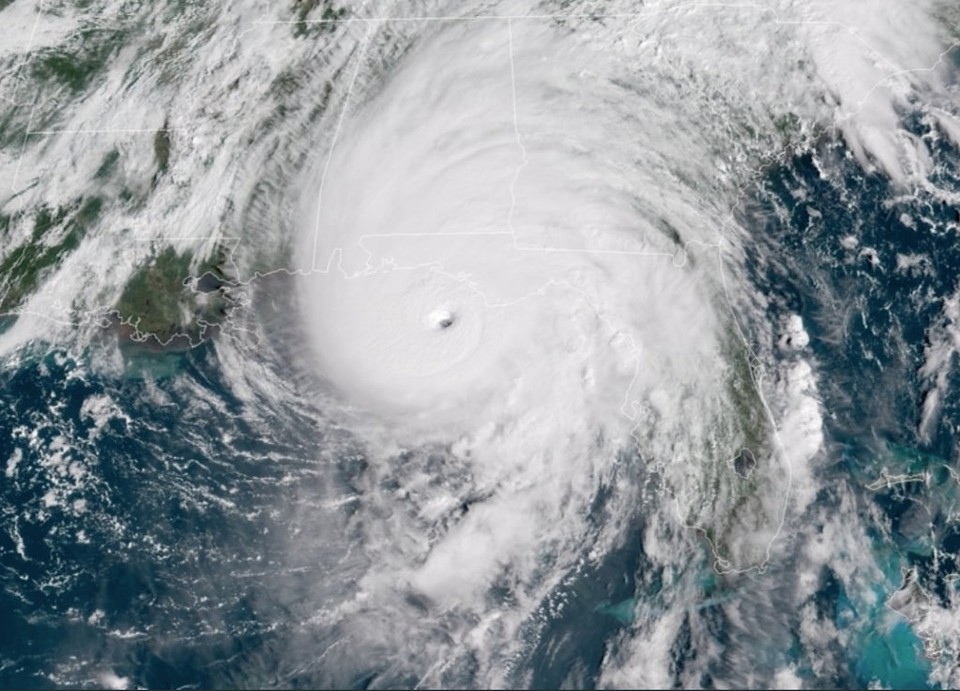 If we consider as the season of cyclones those months when with some probability one can meet at least one cyclone during the month, then such a season begins in November and ends in April.
If we consider as the season of cyclones those months when with some probability one can meet at least one cyclone during the month, then such a season begins in November and ends in April.
Hurricanes and Typhoons Naming Rules
Before the first naming system, hurricanes were named randomly and randomly. Sometimes the hurricane was named after the saint on whose day the disaster occurred. So, for example, the hurricane Santa Anna, which reached the city of Puerto Rico on July 26, 1825, received its name, on St. Anna. The name could be given by the area that suffered the most from the elements, for example, the typhoon of Isenoumi Bay in Japan (September 1959 years), which destroyed the city of Nagoya and claimed 5 thousand human lives.
Sometimes the name was determined by the very form of development of the hurricane. So, for example, the hurricane "Pin" No. 4 got its name in 1935, the shape of the trajectory of which resembled the mentioned object.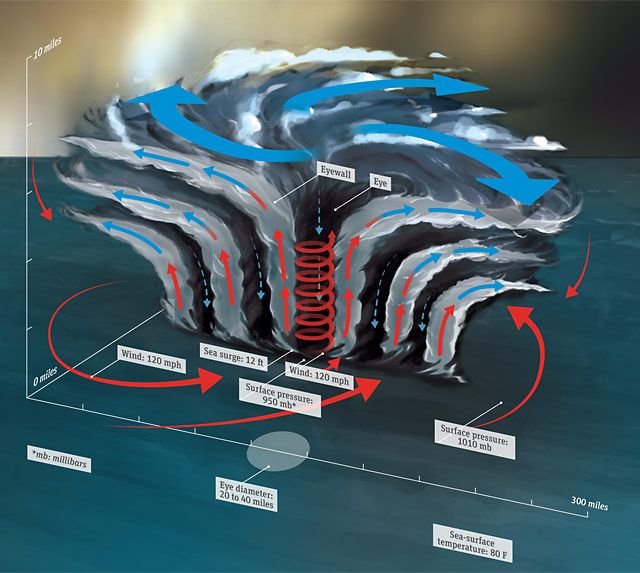
An original method of naming hurricanes, invented by Australian meteorologist Clement Rugg, is known: he named typhoons after members of parliament who refused to vote for meteorological research loans.
Cyclone names became widespread during World War II. US Air Force and Navy meteorologists monitored typhoons in the Pacific Northwest. To avoid confusion, military meteorologists named typhoons after their wives or girlfriends. After the war, the US National Weather Service compiled an alphabetical list of female names. The main idea of this list was to use short, simple and easy to remember names.
By 1950, the first system in the names of hurricanes appeared. First they chose the phonetic army alphabet, and at 1953 decided to return to female names. Subsequently, the naming of hurricanes by women entered the system and was extended to other tropical cyclones - to Pacific typhoons, storms in the Indian Ocean, the Timor Sea and the northwest coast of Australia.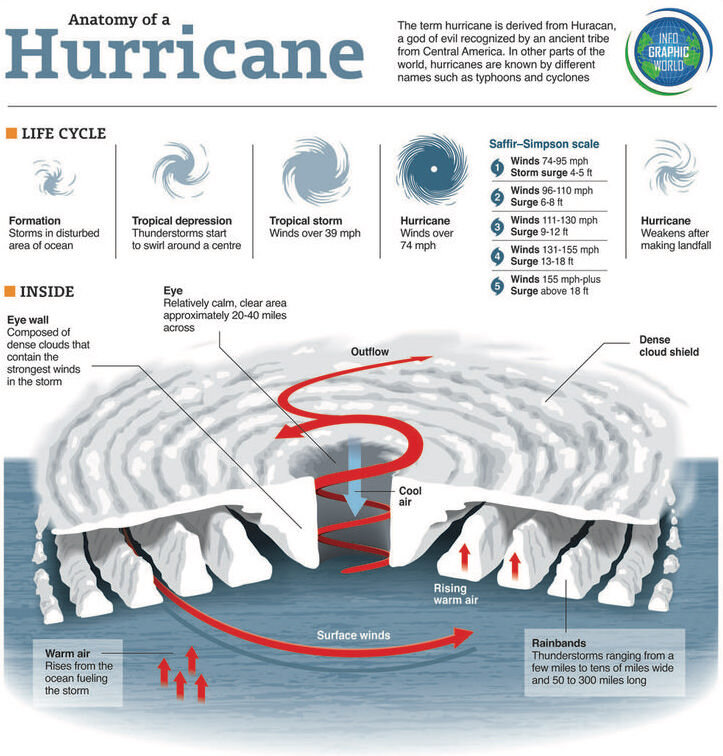 I had to streamline the naming procedure itself. Thus, the first hurricane of the year was called a woman's name beginning with the first letter of the alphabet, the second - with the second, and so on.
I had to streamline the naming procedure itself. Thus, the first hurricane of the year was called a woman's name beginning with the first letter of the alphabet, the second - with the second, and so on.
Names were chosen to be short, easy to pronounce and easy to remember. For typhoons, there was a list of 84 female names. At 19In 79, the World Meteorological Organization (WMO), together with the US National Weather Service, expanded this list to include male names as well.
Since there are several basins where hurricanes form, there are also several lists of names. There are 6 alphabetical lists for Atlantic Basin hurricanes, each with 21 names, used for 6 consecutive years and then repeated. If there are more than 21 Atlantic hurricanes in a year, the Greek alphabet will come into play.
In the event that a hurricane is particularly destructive, the name given to it is struck off the list and replaced by another. So, the name Kartrina is forever crossed out from the list of meteorologists.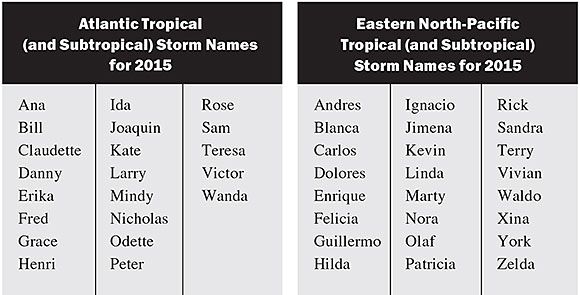
In the Pacific Northwest, names of animals, flowers, trees, and even foods are reserved for typhoons: Nakri, Yufung, Kanmuri, Kopu. The Japanese refused to give female names to the deadly typhoons, because they consider women there to be gentle and quiet creatures.
North Indian Ocean tropical cyclones remain unnamed.
The list for the 2012 hurricane season included Alberto, Beryl, Chris, Debbie, Ernesto, Florence, Gordon, Helen, Isaac, Joyce, Kirk, Leslie, Michael, Nadine, Oscar, Patty, Rafael, Sandy, Tony, Valery, William.
The material was prepared on the basis of information from RIA Novosti and open sources
September 7, 2017, 13:38
TASS-DOSIER. On September 6-7, 2017, Hurricane Irma, which reached its maximum power of the fifth category, passed over the states and territories of the Caribbean, causing severe destruction.
The elements destroyed more than 90% of buildings on the island of Saint-Martin (an overseas community of France) and on the island of Barbuda (the state of Antigua and Barbuda).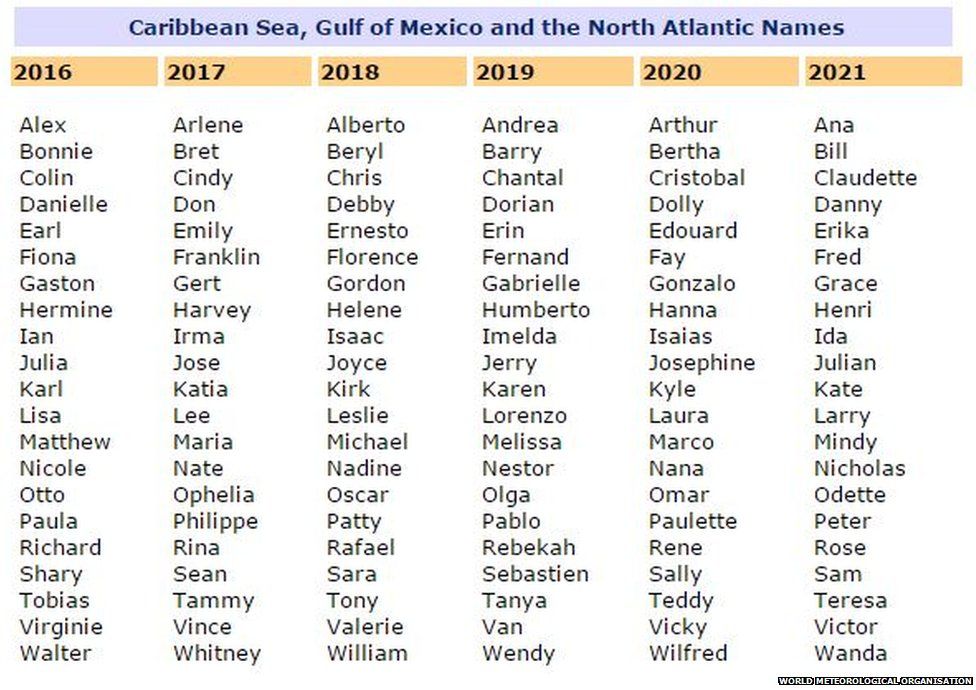 According to the prime minister of this island country, Gaston Brown, the damage amounted to $150 million, or 10% of the country's annual GDP. According to UN estimates, up to 37 million people in the Caribbean could suffer from the effects of the hurricane. According to the US National Hurricane Center, Irma is one of the strongest hurricanes on record.
According to the prime minister of this island country, Gaston Brown, the damage amounted to $150 million, or 10% of the country's annual GDP. According to UN estimates, up to 37 million people in the Caribbean could suffer from the effects of the hurricane. According to the US National Hurricane Center, Irma is one of the strongest hurricanes on record.
The maximum wind speed during the passage of a hurricane is more than 295 km/h (with gusts - up to 380 km/h). Currently, Irma is moving towards the Atlantic coast of the United States.
The TASS-DOSIER editors have prepared material on the most powerful hurricanes over the North Atlantic since 1980.
The Atlantic hurricane season typically runs from June 1 to November 30. At this time, the most powerful cyclones are formed above the surface of the ocean - air masses in the form of a huge atmospheric vortex rotating counterclockwise with low pressure in the center. They are accompanied by thunderstorms, heavy rainfall and strong winds. Cyclones of low intensity are called tropical depressions. When the wind speed exceeds 63 km / h, the cyclone becomes a tropical storm, 118 km / h - a hurricane.
They are accompanied by thunderstorms, heavy rainfall and strong winds. Cyclones of low intensity are called tropical depressions. When the wind speed exceeds 63 km / h, the cyclone becomes a tropical storm, 118 km / h - a hurricane.
Tropical storms and hurricanes have been given proper names by the World Meteorological Organization since the early 1950s. Traditionally, hurricanes are called by English, Spanish and French names. Until 1979, they were only women's, then it was decided to alternate them with men's. The names are repeated every six years, with the exception of those assigned to the most destructive and deadly hurricanes.
The potential damage from hurricanes is measured on the Saffir-Simpson scale. It includes five categories: the first indicates minimal damage, and the fifth - catastrophic.
Hurricanes have been monitored over the North Atlantic since 1851. On average, 18-19 storms and hurricanes occur per season, but in some years their number exceeded 20.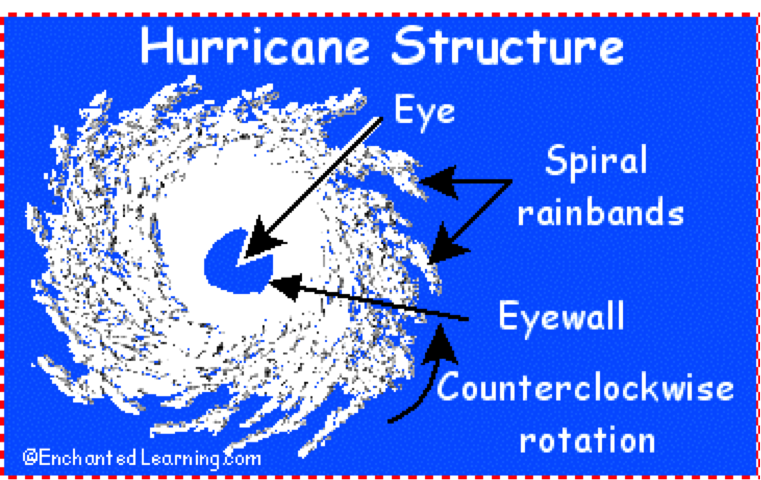
The first category 5 hurricane (wind speed exceeds 252 km/h) was recorded in 1924. According to scientists, it is likely that before that such strong hurricanes passed over the surface of the ocean, bypassing islands and coasts, so data on them were not recorded.
Category 5 hurricanes are rare. According to the US National Oceanic and Atmospheric Administration, since 19In 24 years, only 35 hurricanes (including Irma) have reached such strength. This accounts for about 4% of all Atlantic hurricanes. Most of them were recorded in the period from August to September (the peak season of this natural phenomenon).
The most powerful hurricane in the history of observations is Hurricane Allen, which passed over the Atlantic July 31 - August 11, 1980 . The maximum wind speed reached 305 km/h. The elements affected the Caribbean, northern and eastern Mexico and southern Texas.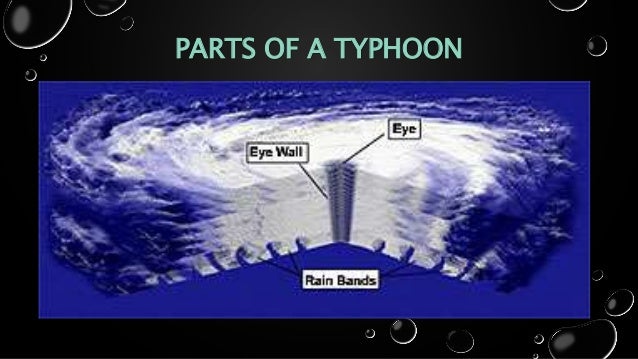 The victims of "Allen" became 269people, property damage amounted to $ 1.3 billion.
The victims of "Allen" became 269people, property damage amounted to $ 1.3 billion.
September 12-19, 1988 Hurricane Gilbert swept over the Caribbean Sea and hit the coast of Mexico (maximum wind speed - 295 km / h). He claimed the lives of more than 300 people, mainly in Mexico, destroyed buildings and almost the entire crop in the affected areas. According to rough estimates, the total economic damage exceeded $7 billion. Four people were killed in the Bahamas by the Andrew, with economic damage amounting to $250 million. However, the southern part of the United States suffered the most losses from the elements, where more than 60 people died, and the restoration cost $26 billion.
October 26 - November 9, 1998 Hurricane Mitch raged over Central America, passing over Honduras, Nicaragua, Guatemala, El Salvador, and the US state of Florida. The maximum sustained wind force was 285 km/h (with gusts up to 320 km/h).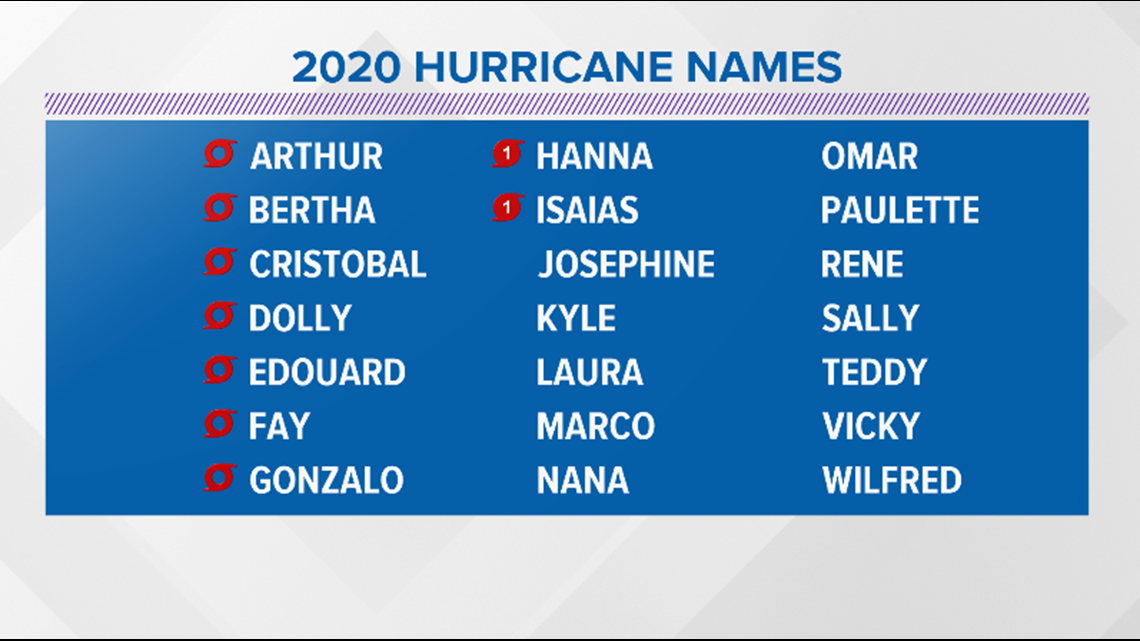 The exact number of victims has not been established. According to approximate data, their number exceeds 20 thousand people (11 thousand dead and about the same number missing). In terms of the number of victims and the scale of destruction, Mitch is second only to the Great Hurricane San Calixto II, which hit the Caribbean in 1780, when more than 27 thousand people died. Hurricane Mitch left 2.7 million people homeless (most of them residents of Honduras and Nicaragua), causing more than $6 billion in economic damage.
The exact number of victims has not been established. According to approximate data, their number exceeds 20 thousand people (11 thousand dead and about the same number missing). In terms of the number of victims and the scale of destruction, Mitch is second only to the Great Hurricane San Calixto II, which hit the Caribbean in 1780, when more than 27 thousand people died. Hurricane Mitch left 2.7 million people homeless (most of them residents of Honduras and Nicaragua), causing more than $6 billion in economic damage.
September 6, 2003 Storm Isabel formed over the Atlantic, which then developed into a hurricane and reached the fifth category of power (maximum wind speed - 270 km / h). It hit the islands of the Caribbean and reached the southern states of the United States. The hurricane killed 17 people, more than 30 people died as a result of the flooding it caused. $3.6 billion needed to rebuild devastated areas
September 2-24, 2004 Hurricane Ivan raged over the Caribbean Sea, the Gulf of Mexico and the Atlantic coast of the United States (maximum speed - 270 km / h). During its passage, it caused the largest number of tornadoes than all other hurricanes in the history of observations - more than 100. Grenada, Jamaica, the Cayman Islands, Cuba, as well as the US states of Florida and Alabama suffered the most from the elements. The total number of deaths is more than 90 people, material damage amounted to $23 billion
During its passage, it caused the largest number of tornadoes than all other hurricanes in the history of observations - more than 100. Grenada, Jamaica, the Cayman Islands, Cuba, as well as the US states of Florida and Alabama suffered the most from the elements. The total number of deaths is more than 90 people, material damage amounted to $23 billion
August 25-29, 2005 Hurricane Katrina, one of the most destructive hurricanes in the United States, hit the Gulf of Mexico and the southern coast of the United States (maximum wind speed - 280 km / h). The states of Florida, Alabama, Louisiana and Mississippi suffered from the elements. The greatest damage was caused to New Orleans, about 80% of the city's area was under water. As a result of the natural disaster, 1,836 people died. Property damage from the hurricane exceeded $108 billion
September 18-26, 2005 Hurricane Rita passed over the Gulf of Mexico and the United States (maximum sustained speed - 285 km / h).